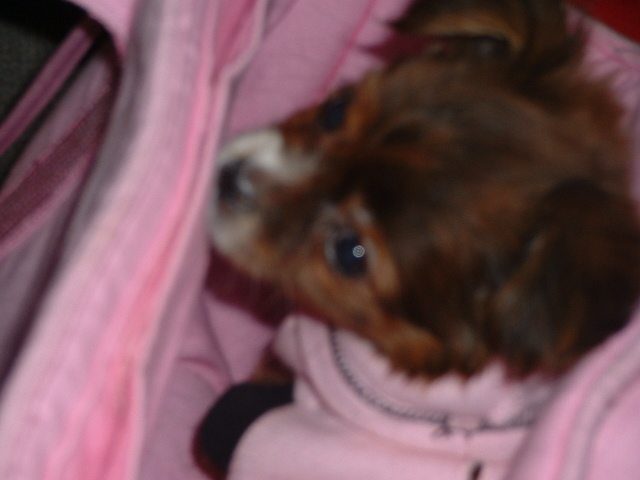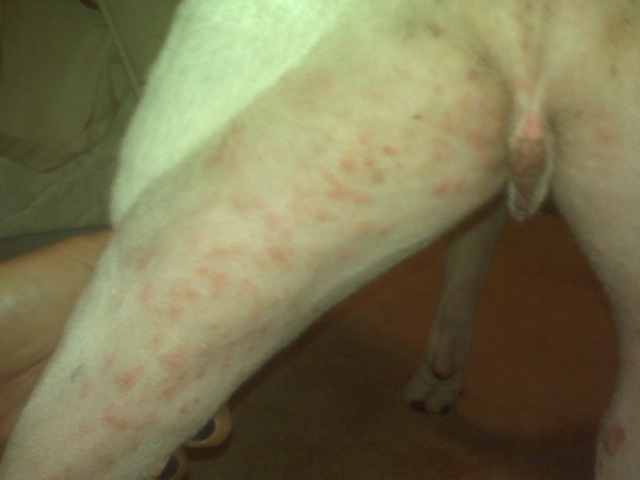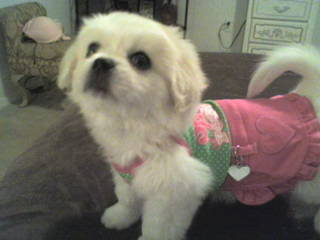QuestionI am highly concerned to learn that food like Eukanuba is not to be fed to our dogs? Why?
Iams also and they make that brand.
What is good dog kibble to buy that does not cost an arm and a leg.?
What tool is needed to train my dog?
What should my dog learn?
Thanks for your time..
AnswerPat, you got one right in your guesses, though you didn't say which one you thought was a store brand. That's ok though. Here're the answers:
Food #1 - Eukanuba
Food #2 - Science Diet
Food #3 - Nutro Max
Food #4 - Iams Chunks
Food #5 - Store brand, Wal-Mart's Maxximum Nutrition to be exact
Food #6 - Purina Dog Chow
Now; let me explain why none of these foods are desirable. If you noticed, in all of the ingredients listings that I gave, there was some form of corn. Four of the foods had a form of yeast listed. In three of the foods, there was at least one form of wheat (Nutro Maxx had wheat listed twice!). In three of the foods sorghum was listed. And two of the foods had a form of soy listed.
All of the above, with the exception of yeast, are forms of cereal grains. Cereal grains provide very little, if any, nutrition for dogs. They serve one major purpose, and that is to make the dog feel full. That's why they are called "fillers." They pass through the dog's system and right back out again in the form of waste. Generally, the more grains a dog consumes, the more poo it produces. Granted, there IS some nutrition in grain; but dogs simply are not able to absorb it. White rice is about the only grain that dogs can utilize. Unlike humans, dogs get more out of white rice than brown rice. All of the above, including yeast, have been proven to cause or contribute to canine allergies. Dogs with food allergies frequently lick and chew at their paws, have itchy and/or dry skin, shed more frequently and have brittle or otherwise unhealthy fur, and can even develop digestive disorders and even ear and skin infections.
Some other items you may have noticed in the ingredients listings include by-product meal, animal fat, and animal digest. By-products are any part of an animal that is not consumed by humans. For example, chicken by-product meal can include intestines, stomach, and other organ and tissue meat (which are actually good for your dog-this is what wolves and other wild predators eat first when they make a kill). However, chicken by-product meal can also include chicken heads, necks, feet, lungs, spleen, kidneys, brain, livers, feathers, blood, bone, skin, and minute traces of feces. There really are no limits, since by-product is defined as whatever parts of the animal are not used for human consumption. In beef by-product meal, hooves, hide, and horns can be included. In animal by-product meal, you have no way of knowing WHAT is included.
Animal fat, in some form or fashion, preserved with mixed tocopherols is added to help make the food more palatable (tasty) to your dog. Ingredients labels will frequently say (source of vitamin E) afterwards. The animal fat itself is not the source of vitamin E. The tocopherols are. Dogs DO need some fat in their diets, but as a rule, you should stay away from foods that have it listed as just "animal fat", and try to stay away from foods that have it very close to the top of the ingredients list. Poultry fat, chicken fat, or beef fat is better because you know for certain where it came from. Animal fat tells you nothing about where it came from. It's very generic.
Animal digest is a powder or liquid made by taking clean undecomposed animal tissue and breaking it down using chemical and or emblematic hydrolysis. Mmm doesn't that sound tasty?
------------------------------------------------------------
Now, here's another thing to think about when you look at an ingredient label. We'll use Wal-Mart's Maxximum Nutrition as an example. Here is their ingredients listing again:
Chicken, brewers rice, whole grain corn, corn gluten meal, poultry by-product meal (natural source of glucosamine), whole grain wheat, animal fat preserved with mixed-tocopherols (form of Vitamin E), animal digest, chicken cartilage (natural source of glucosamine), dicalcium phosphate, salt, malted barley flour, potassium chloride, calcium carbonate, choline chloride, L-Lysine monohydrochloride, zinc sulfate, Vitamin E supplement, ferrous sulfate, manganese sulfate, niacin, Vitamin A supplement, calcium pantothenate, thiamine mononitrate, copper sulfate, riboflavin supplement, Vitamin B-12 supplement, pyridoxine hydrochloride, garlic oil, folic acid, Vitamin D-3 supplement, calcium iodate, biotin, menadione sodium bisulfite complex (source of Vitamin K activity), sodium selenite.
Now, look closely at the first 6 ingredients. The first ingredient is chicken, which is good. This means that the first ingredient is the clean flesh derived from slaughtered [chickens] and is limited to that part of the striate muscle which is skeletal or that which is found in the tongue, in the diaphragm, in the heart, or in the esophagus; with or without that accompanying and overlying fat and the portions of the skin, sinew, nerve, and blood vessels which normally accompany the flesh. The next ingredients are brewers rice, whole grain corn, corn gluten meal, poultry by-product meal, and whole grain wheat. This means that there is actually more grain by volume than there is chicken. If you combined the brewers rice, corn, corn gluten meal, and wheat; there would be more than there was of the listed first ingredient. This is known as "splitting." If a label reads "Chicken, ground yellow corn, rice, and corn gluten meal," it appears that there is <i>less</i> corn than chicken, even though the corn products in the food actually <i>weigh more</i> than the chicken. So in fact, the first 6 ingredients on the ingredients listing should read something like:
Corn, chicken, brewers rice, poultry by-product meal, wheat...
------------------------------------------------------------
Are you totally lost? I'll stop there for now and give you some links to help you better understand what I've compacted into a nutshell.
You asked what foods are better, and affordable. Below is a list of foods that I recommend. At first, they may seem much more expensive (but if you've been feeding Iams or Eukanuba, they're about the same price-wise). But, in the long run, they are cheaper because your dog will be more healthy and require fewer trips to the vet (all dogs should have a yearly exam no matter how healthy they seem), your dog will end up having to eat less because their body will be able to absorb and utilize more of the nutrition in the food - so a bag will last you longer, and you'll be cleaning up less poop. That, in itself, should be enough to make you want to switch! :^D
Here are the foods that I recommend. While many of the websites offer the food for sale, try to see if you can find a store local to you that sells whatever food you're interested in. Most of the time it's cheaper that way.
1. Wellness (www.oldmotherhubbard.com) - By far, this is one of THE best commercial kibbles on the market. It is the most expensive food in this list, but it's a wonderful product.
2. Solid Gold (www.solidgoldhealth.com) - This food is roughly $1 a pound depending on which formula you choose. That is about the same as what you pay for Eukanuba.
3. Canidae (www.canidae.com)
4. Innova, California Natural, Healthwise, Karma Organic (www.naturapet.com) - These are all made by the same company.
5. Nutro Natural Choice (www.nutroproducts.com) - This food is also about $1 a pound. Very affordable.
6. Chicken Soup for the Dog Lover's Soul (www.chickensoupforthepetloverssoul.com) - This food is made by Diamond, but is MUCH better than Diamond dog food. In my experience, it is a little overpriced, maybe because it contains duck and salmon, but it is a good food.
7. Nature's Recipe (www.naturesrecipe.com) - I like their allergy formula made with Venison, and as long as your dog isn't allergic to wheat, their regular line would be ok as well.
8. Royal Canin (www.royalcanin.us) - Their regular line is okay, but it does contain corn gluten meal in the ingredients listing, so if your dog is allergic to corn I would stay away from their regular line of food and go with their "Sensible Choice" food instead.
9. Blue Buffalo - This food doesn't have its own website, but PetSmart carries it. It is rather pricey though.
10. Purina Pro Plan (www.proplan.com) - This is the ONLY product made by Purina that I will say anything good about. However, the only formula I would really recommend is the "Sensitive Skin & Stomach Formula." It doesn't have corn in it like the others do.
11. Life's Abundance (www.healthypetnet.com)
That will hopefully give you a better idea of what foods are best. You can use your best judgement on what to choose.
This website goes into a little more detail and may help you to make an educated decision on what food to choose: http://www.api4animals.org/79.htm
And here are some links that will also tell you why I am not a fan of Iams products:
http://www.iamskills.com/
http://www.uncaged.co.uk/iams.htm
http://www.stopanimaltests.com/
http://www.iamsodead.com/iams.asp
http://www.iamscruelty.com/iams-feat-nocontract.asp
http://www.petsnfamily.com/pet_home_n16.html
------------------------------------------------------------
Ok. You also asked about training. If you'll tell me what kind of dog you have, how old it is, and whether it's a primarily inside or primarily outside dog, I'll try to help you. You asked what tool is needed to train your dog; it depends on what breed it is and how old, and it also depends on what method(s) you prefer. You also asked what should your dog learn; that's up to you. What do you want him to learn?
Again, I'll be more than happy to help you, but I need a little more info from you first!
Kristen

 Puppy wont come
Question
Capone & Rascal
Help! My seven week
Puppy wont come
Question
Capone & Rascal
Help! My seven week
 Nutrition & Health
Question
Peek-A-Boo!
Hello! I am new to owning small br
Nutrition & Health
Question
Peek-A-Boo!
Hello! I am new to owning small br
 worried about mom dog not lactating enough
Question
angel and her pups jus
I have a small mixed br
worried about mom dog not lactating enough
Question
angel and her pups jus
I have a small mixed br
 Large dog with possible poison ivy
Question
Guero
My poor dog has led a rough life to date
Large dog with possible poison ivy
Question
Guero
My poor dog has led a rough life to date
 Helpppp
Question
Maddy
I have a 9 month peekapoo. She is pad tr
Helpppp
Question
Maddy
I have a 9 month peekapoo. She is pad tr